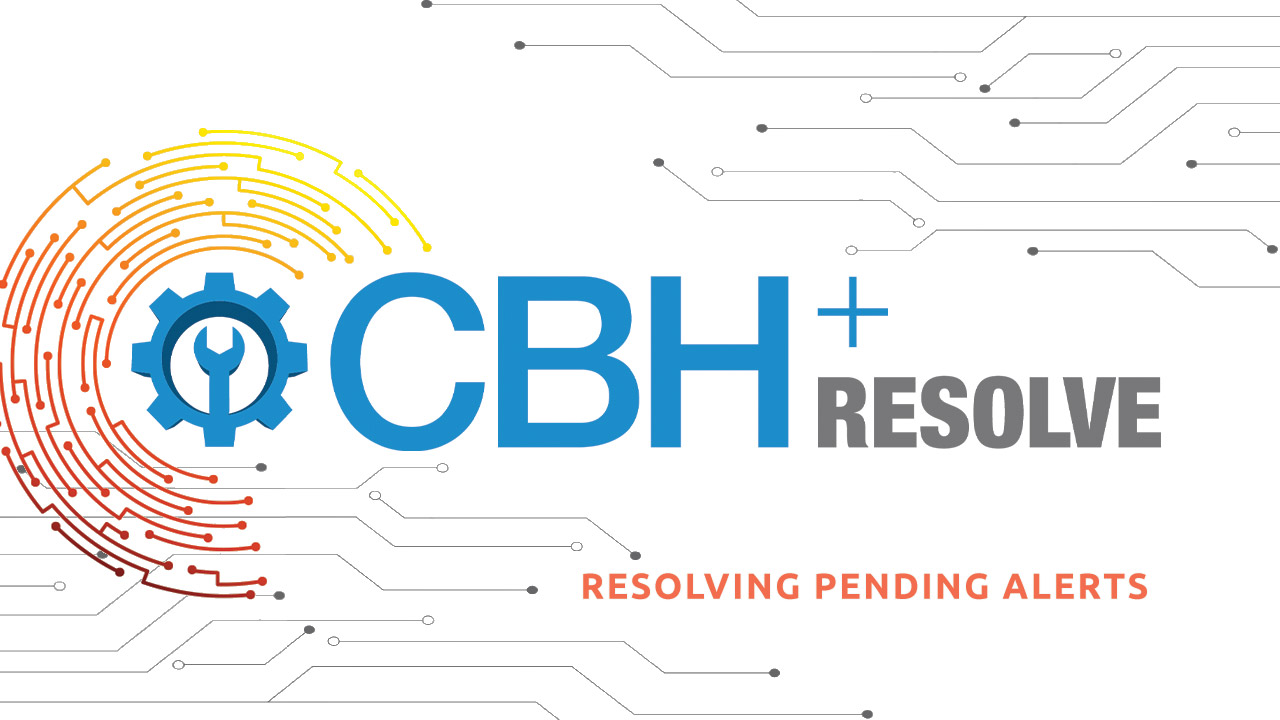How To Look Up and Resolve Pending Alerts

[fusion_separator style_type=”single solid” hide_on_mobile=”small-visibility,medium-visibility,large-visibility” sticky_display=”normal,sticky” class=”” id=”” flex_grow=”0″ top_margin=”10px” bottom_margin=”10px” width=”” alignment=”center” border_size=”” sep_color=”” icon=”” icon_size=”” icon_color=”” icon_circle=”” icon_circle_color=””][/fusion_separator]
Starting from the dashboard, you’ll see your pending alerts total up top. Click the number and this will take you to the resolve module with all your pendings already listed out. You can also navigate here from anywhere in the portal by clicking Resolve in the left hand sidebar. You’ll have to select “pending” then “search” and that gets you all your pendings if you take this route.
As always with CBH+ data tables, you can organize your results further by sorting the column values. Here, I’ll sort by alert type, and deal with my fraud alerts first.
A powerful note on sorting columns: You can use this feature to find patterns in your disputes. Let’s say you’re consistently seeing a certain bin number or descriptor, you may have an opportunity to automate the resolve process, and set rules that will trigger an automated resolution. This reduces your number of alerts and saves you time and money. If a certain descriptor is generating alerts, you may want to optimize it better… Sorting can help you better understand how to reduce your disputes. Contact us to learn more.
So I’ve got my list of pending alerts here and I am ready to drill down.
You can do this in two ways: by clicking “Resolve” or by clicking the “ID”. When you hit resolve, the alert will be locked and can’t be modified by anyone else. If you’re just looking up an alert for information, click ID. If you’re resolving or modifying alerts, then click resolve.
This gives you a popup of the individual alert, you’ll see the status up top and an abundance of information on the transaction in question. Again, if you’re seeing patterns, say a particular BIN or issuer that’s generating a lot of alerts, you have an automation opportunity to optimize your workflow.
If you’re resolving alerts, you’ll copy the card number displayed here, then log in to your gateway to find the transaction. That’s where you actually refund the money in case of fraud. You can also see if the transaction was already cancelled by the issuer or acquirer, in which case you’re eligible for a credit for that alert.
Whatever the case, you’ll then return to the portal and annotate the Outcome. “Outcome” lists out all the general actions you can take for that alert and “Refunded” lets you set the more specific step you took to resolve the alert.
You have a notes field here to make a note of anything out of the ordinary you come across in resolving the alert. An example would be if a transaction was not authorized, yet you received an alert, Notes is where you would point that out.
In a case like that, where you’re eligible for a credit, once you apply for that credit, you’ll come back to the alert, click “MARK CREDIT” and enter the date you applied for it. Hit SAVE and you’ll see that input reflected up top. Once your credit is processed you’ll return to enter either its approval or denial date there as well.
The “MARK AS CHARGEBACK” button covers a couple of scenarios. If a chargeback was issued before the alert, or after your refunded the alert, it would be marked as a chargeback. Or if you’re enrolled in our Recover module, you would make the alert as a chargeback to initiate the representment process.
If you’re not sure about an alert or you’re facing technical or procedural challenges, we’re here for you. Simply hit “CLICK FOR HELP”, describe your issue, and a qualified specialist with get back to you right away.
In a routine scenario, you’ve refunded the alert, and made your annotations, click “SAVE AND NEXT” to move through your next alert. If you’re done working alerts for the day, then just hit save.
That’s how you look up and manage your pending alerts in the RESOLVE module. Be sure to contact your ChargebackHelp specialist with any further questions or issues.
Thank you for tuning in to our ChargebackHelp tutorials series, and thank you as always for partnering with us.






